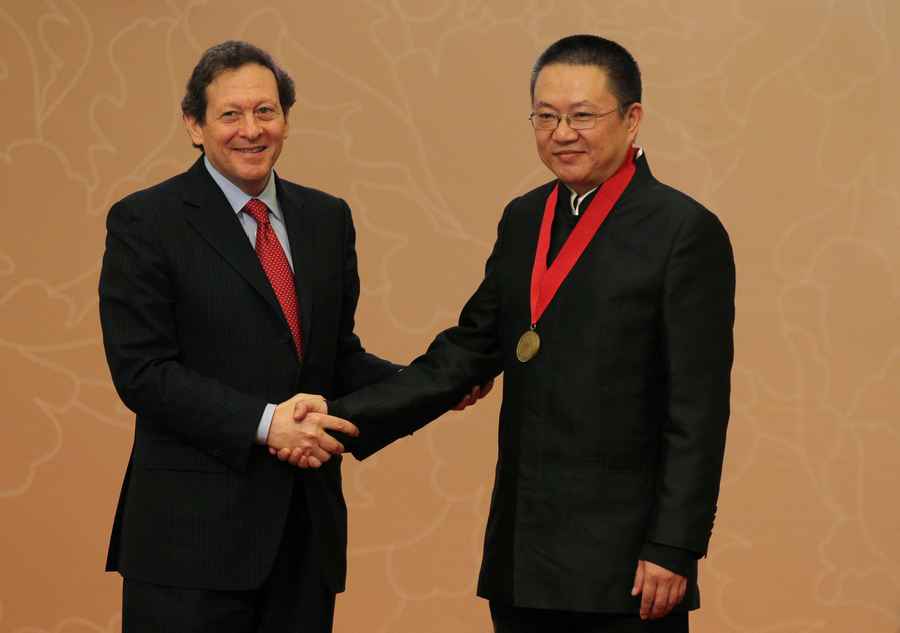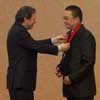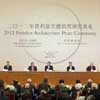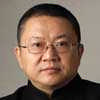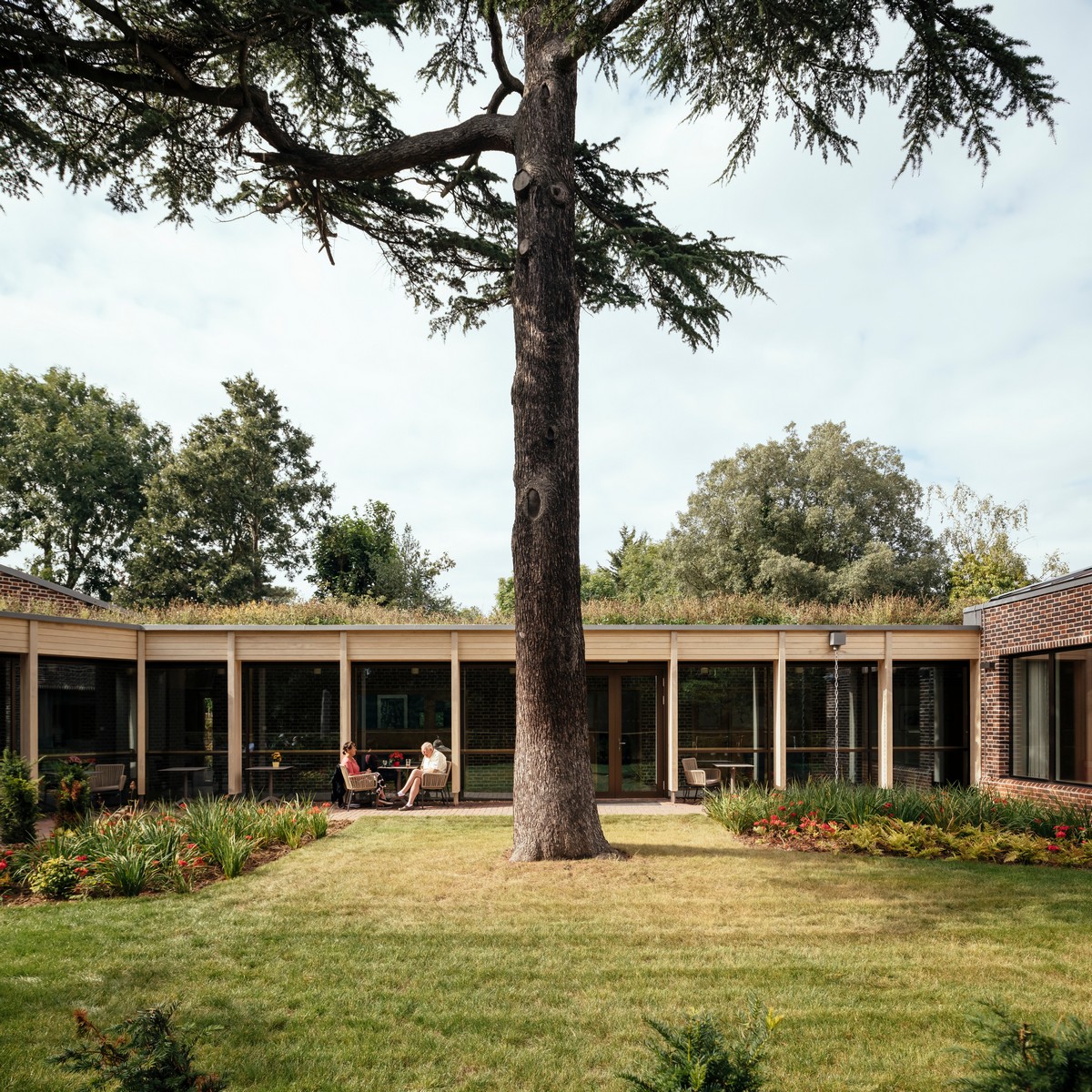Pritzker Prize Winner 2012, Global Architecture Award, Architects, Designer, Jury News
Pritzker Architecture Prize 2012
Wang Shu – International Architect Award – Results through the Years
31 May 2012
Beijing Ceremony for Pritzker Prize to Wang Shu
Wang Shu architect Pritzker Prize 2012 Winner:
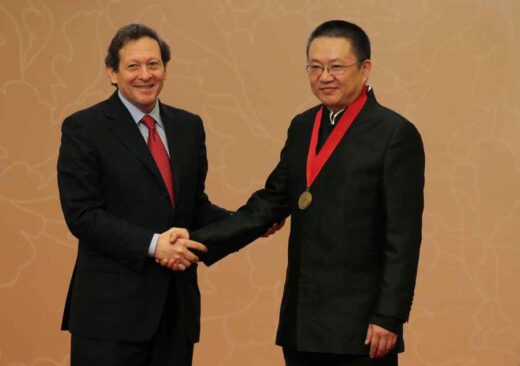
photo from ceremony
Wang Shu of the People’s Republic of China
Awarded the 2012 Pritzker Architecture Prize Laureate at the
Great Hall of the People in Beijing
Pritzker Architecture Prize Ceremony 2012
Thomas J. Pritzker, chairman of The Hyatt Foundation presented the 2012 Pritzker Architecture Prize to Wang Shu, the first architect from the People’s Republic of China to receive what is considered architecture’s most prestigious award at the Great Hall of the People in Beijing. This thirty-fourth annual ceremony which moves around the world each year, took place on 25 May. Renowned as the “the Nobel of architecture” the official ceremony was hosted for the first time in China since the prize was founded in 1979.
On the dais for the presentation were Chinese government dignitaries, including His Excellency Li Keqiang, Vice Premier of the State Council of the People’s Republic of China; His Excellency Liu Qi, Secretary of the Beijing Municipal Committee; Mr. Jiang Weixin, Minister of the Housing and Urban-Rural Development; Mr You Quan, Deputy Secretary of the State Council; and Mr Guo Jinlong, Mayor of Beijing.
“Hosting the Ceremony at the Great Hall of the People is significant, not just to China, but also to the world,” said Thomas J Pritzker. “This prize ceremony has taken place in many places around the world, including the White House in Washington DC, a public square in Rome that was designed by Michelangelo, by the Wall of the Second Temple in Jerusalem; and an ancient Buddhist temple in Nara, Japan. I first visited China in 1976, so I have had the great privilege of witnessing its evolution over the last three decades. Like this Hall, China’s evolution has been about its people and that is what enlightened architecture is also about.”
The official ceremony granting the award takes place every year at an architecturally significant site throughout the world paying homage to the architecture of other eras and/or works by previous laureates of the prize. The choice of location of the ceremony reinforces the importance of the built environment while providing a unique setting for the ceremony. Since the ceremony locations are usually chosen each year long before the laureate is selected, there is no direct relationship between the honoree and the ceremony venue. This year is the third time in the prize history that an international location coincides with the chosen laureate’s home nation. The two prior coincidences were in 1990 when the late Aldo Rossi of Italy was the honoree and the ceremony was held in Venice; and again in 2007, British architect Richard Rogers was the laureate and the ceremony was held in London.
Thomas J Pritzker further elaborates, “This ceremony goes beyond our expectations. We celebrate one of China’s own sons as great and world-class architect. By honoring Wang Shu, we honor not only a man, but we also honor a country and a culture that was able to foster an architect of such skill, intellect and vision. Wang was born here, educated here and this is where he has turned his ideas, energy and effort into buildings that serve their communities.”
“In the last twenty years, the world has been enriched by China’s remarkable progression of success in commerce and industry.” Lord Palumbo, chairman of the Pritzker Prize jury said during the jury citation. “This rate-of-change can only be described as phenomenal. The vitality of the economy has found expression in architecture. With an entirely healthy but burning ambition, China has become an architectural laboratory for the world and consequently the most competitive market in the world for those who design buildings. This competitive activity is stimulating the creation of a new Chinese architecture that respects tradition and locality, but that also recognizes and responds to the urgency of current needs.”
Lord Palumbo further explained, “This is a difficult balance to achieve, but in the works of Wang Shu the jury saw the emergence for the first time of truly authentic contemporary Chinese architecture; for here are buildings of compelling originality that not only address the future but also draw meaning and value from the past. If the architecture of Wang Shu is rooted in China’s long and honorable tradition, culture, and locality, it also sends important signals to the rest of the world as a result of his distinctive architectural language that speaks to everyone. For all these reasons, Wang Shu is a worthy Laureate of the world’s most prestigious architectural accolade. We also believe that he will be the first, but by no means that last in a line of great contemporary Chinese architects.”
In accepting the Pritzker Prize, Wang Shu said, “Winning this award is something unexpected. For many years, I have been pursuing my dream on a lonely course. Before this, I had never published any architectural design collection or designed any buildings outside of China. I always see myself as an amateur architect, so it is absolutely a huge pleasant surprise to receive this honor. I wish to thank the judges for their insight and fair comments. This award is of special importance for the Chinese architectural industry. As a young architect, I have to say that I owe this award to the age we now live in. It is in this golden age that China has achieved unprecedented prosperity and openness, giving me so many opportunities for making difficult architectural experiments in such a short span of time. Here, I wish to thank my partner Lu Wenyu and all my friends who have helped me before.”
Wang Shu further explained, “I always say that I am not just designing a building, but a world of diversity and difference and a path that leads us back to the nature. These are the questions I was asking myself when I got to know that I was given the award, and these are the questions I will continue to focus on in my future endeavors.”
27 Feb 2012
Pritzker Architecture Prize 2012 News
Pritzker Architecture Prize Winner News
WANG SHU NAMED 2012 PRITZKER PRIZE WINNER
Wang Shu, a 48 year old architect whose architectural practice is based in Hangzhou, The People’s Republic of China, will be the recipient of the 2012 Pritzker Architecture Prize.
Jury Chair Lord Palumbo, stated, “Wang Shu’s oeuvre, seen in depth by the jurors during a visit to China, left no doubt that we were witnessing the work of a master; and a unanimous decision to award him the Pritzker Prize for 2012 is one that we feel places him at the same high level of distinction as the other Chinese architect to receive the award, I M Pei.”
Wang Shu of The People’s Republic of China Is the 2012 Pritzker Architecture Prize Laureate
Los Angeles, CA – Wang Shu, a 48 year old architect whose architectural practice is based in Hangzhou, The People’s Republic of China, will be the recipient of the 2012 Pritzker Architecture Prize, it was announced today by Thomas J. Pritzker, chairman of The Hyatt Foundation which sponsors the prize. The formal ceremony for what has come to be known throughout the world as architecture’s highest honor will be in Beijing on May 25.
In announcing the jury’s choice, Pritzker elaborated, “The fact that an architect from China has been selected by the jury, represents a significant step in acknowledging the role that China will play in the development of architectural ideals. In addition, over the coming decades China’s success at urbanization will be important to China and to the world. This urbanization, like urbanization around the world, needs to be in harmony with local needs and culture. China’s unprecedented opportunities for urban planning and design will want to be in harmony with both its long and unique traditions of the past and with its future needs for sustainable development.”
Library of Wenzheng College, Suzhou, China
1999-2000
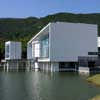
photo by Lu Wenyu, Courtesy of Amateur Architecture Studio
The purpose of the Pritzker Architecture Prize, which was founded in 1979 by the late Jay A. Pritzker and his wife, Cindy, is to honor annually a living architect whose built work demonstrates a combination of those qualities of talent, vision and commitment, which has produced consistent and significant contributions to humanity and the built environment through the art of architecture. The laureates receive a $100,000 grant and a bronze medallion.
Pritzker Prize jury chairman, The Lord Palumbo, spoke from his home in the United Kingdom, quoting from the jury citation that focuses on the reasons for this year’s choice: “The question of the proper relation of present to past is particularly timely, for the recent process of urbanization in China invites debate as to whether architecture should be anchored in tradition or should look only toward the future. As with any great architecture, Wang Shu´s work is able to transcend that debate, producing an architecture that is timeless, deeply rooted in its context and yet universal.”
Wang earned his first degree in architecture at the Nanjing Institute of Technology, Department of Architecture in 1985. Three years later, he received his Masters Degree at the same institute. When he first graduated from school, he went to work for the Zhejiang Academy of Fine Arts in Hangzhou doing research on the environment and architecture in relation to the renovation of old buildings. Nearly a year later, he was at work on his first architectural project – the design of a 3600 square meter Youth Center for the small town of Haining (near Hangzhou). It was completed in 1990.

photo © 2012 The Hyatt Foundation
For nearly all of the next ten years, he worked with craftsmen to gain experience at actual building and have no responsibility for design. In 1997, Wang Shu and his wife, Lu Wenyu, founded their professional practice in Hangzhou, naming it “Amateur Architecture Studio.” He explains the name, “For myself, being an artisan or a craftsman, is an amateur or almost the same thing.” His interpretation of the word is relatively close to one of the unabridged dictionary’s definitions: “a person who engages in a study, sport or other activity for pleasure rather than for financial benefit or professional reasons”. In Wang Shu’s interpretation, the word “pleasure” might well be replaced by “love of the work”.
By the year 2000, he had completed his first major project, the Library of Wenzheng College at Suzhou University. In keeping with his philosophy of paying scrupulous attention to the environment, and with careful consideration of traditions of Suzhou gardening which suggests that buildings located between water and mountains should not be prominent, he designed the library with nearly half of the building underground. Also, four additional buildings are much smaller than the main body. In 2004, the library received the Architecture Art Award of China.
Ningbo Contemporary Art Museum, Ningbo, China
2001-05
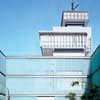
photo by Lv Hengzhong, Courtesy of Amateur Architecture Studio
His other major projects completed, all in China, include in 2005, the Ningbo Contemporary Art Museum and five scattered houses in Ningbo which received acknowledgment from the Holcim Awards for Sustainable Construction in the Asia Pacific. In that same city, he completed the Ningbo History Museum in 2008. In his native city of Hangzhou, he did the first phase of the Xingshan Campus of the China Academy of Art in 2004, and then completed phase two of the same campus in 2007.
True to his methods of the economy of materials, he salvaged over two million tiles from demolished traditional houses to cover the roofs of the campus buildings. That same year in Hangzhou, he built the Vertical Courtyard Apartments, consisting of six 26-storey towers, which was nominated in 2008 for the German based International High-Rise Award. Also finished in 2009 in Hangzhou, was the Exhibition Hall of the Imperial Street of Southern Song Dynasty. In 2006, he completed the Ceramic House in Jinhua.
Other international recognition includes the French Gold Medal from the Academy of Architecture in 2011. The year before, both he and his wife, Lu Wenyu, were awarded the German Schelling Architecture Prize.
Xiangshan Campus, China Academy of Art, Phase II, Hangzhou, China
2004-07
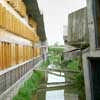
photos by Lv Hengzhong, Courtesy of Amateur Architecture Studio
Since 2000, Wang Shu has been the head of the Architecture Department of the China Academy of Art in Hangzhou, the institution where he did research on the environment and architecture when he first graduated from school. Last year, he became the first Chinese architect to hold the position of “Kenzo Tange Visiting Professor” at Harvard Graduate School of Design in Cambridge, Massachusetts. He is also a frequent visiting lecturer at many universities around the world, including in the United States: UCLA, Harvard, University of Texas, University of Pennsylvania, He has participated in a number of major international exhibitions in Venice, Hong Kong, Brussels, Berlin and Paris.
Upon learning that he was being honored, Wang Shu had this reaction: “This is really a big surprise. I am tremendously honored to receive the Pritzker Architecture Prize. I suddenly realized that I’ve done many things over the last decade. It proves that earnest hard work and persistence lead to positive outcomes.”
The distinguished jury that selected the 2012 Pritzker Laureate consists of its chairman, The Lord Palumbo, internationally known architectural patron of London, chairman of the trustees, Serpentine Gallery, former chairman of the Arts Council of Great Britain, former chairman of the Tate Gallery Foundation, and former trustee of the Mies van der Rohe Archive at the Museum of Modern Art, New York; and alphabetically: Alejandro Aravena, architect and executive director of Elemental in Santiago, Chile; Stephen Breyer, U.S. Supreme Court Justice, Washington, D.C.; Yung Ho Chang, architect and educator, Beijing, The People’s Republic of China; Zaha Hadid, architect and 2004 Pritzker Laureate; Glenn Murcutt, architect and 2002 Pritzker Laureate of Sydney, Australia; Juhani Pallasmaa, architect, professor and author of Helsinki, Finland; and Karen Stein, writer, editor and architectural consultant in New York. Martha Thorne, associate dean for external relations, IE School of Architecture, Madrid, Spain, is the executive director of the prize.
Ningbo History Museum, Ningbo, China
2003-08
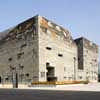
photo by Lv Hengzhong, Courtesy of Amateur Architecture Studio
In addition to the previous laureates already mentioned, the late Philip Johnson was the first Pritzker Laureate in 1979. The late Luis Barragán of Mexico was named in 1980. The late James Stirling of the United Kingdom was elected in 1981, Kevin Roche in 1982, Ieoh Ming Pei in 1983, and Richard Meier in 1984.
Hans Hollein of Austria was the 1985 Laureate. Gottfried Böhm of Germany received the prize in 1986. Robert Venturi received the honor in 1991, and Alvaro Siza of Portugal in 1992. Christian de Portzamparc of France was elected Pritzker Laureate in 1994. Frank Gehry of the United States was the recipient in 1989, the late Aldo Rossi of Italy in 1990. In 1996, Rafael Moneo of Spain was the Laureate; in 1997 the late Sverre Fehn of Norway; in 1998 Renzo Piano of Italy, in 1999 Sir Norman Foster of the UK, and in 2000, Rem Koolhaas of the Netherlands.
Australian Glenn Murcutt received the prize in 2002. The late Jørn Utzon of Denmark was honored in 2003; Zaha Hadid of the UK in 2004; and Thom Mayne of the United States in 2005. Paulo Mendes da Rocha of Brazil was the Laureate in 2006, and Richard Rogers received the prize in 2007. Jean Nouvel of France was the Laureate in 2008. In 2009, Peter Zumthor of Switzerland received the award. In 2010, two Japanese architects were honored, partners Kazuyo Sejima and Ryue Nishizawa of SANAA, Inc. Last year, Eduardo Souto de Moura of Portugal was the laureate.
The field of architecture was chosen by the Pritzker family because of their keen interest in building due to their involvement with developing the Hyatt Hotels around the world; and because architecture was a creative endeavor not included in the Nobel Prizes. The procedures were modeled after the Nobels, with the final selection being made by the international jury with all deliberations and voting in secret. Nominations are continuous from year to year with hundreds of nominees from countries all around the world being considered each year.
27 Oct 2011
Pritzker Prize Ceremony – 2012
Pritzker Architecture Prize Ceremony Will Be Held in China Next Year
The 2012 Pritzker Architecture Prize Ceremony will be held in Beijing, China on May 25, 2012, it was disclosed today In a joint announcement by Guo Jinlong, the Mayor of Beijing, China and Thomas J. Pritzker, Chairman of The Hyatt Foundation.
Pritzker elaborated, “Over the three decades of prize-giving, we have held ceremonies in fourteen different countries, in venues ranging from the White House in Washington DC to Todai-ji Temple in Nara, Japan. The tradition of moving the event to world sites of architectural significance was established to emphasize that the prize is international, the laureates having been chosen from 16 different nations to date. This will be our 34th event marking the first time we have gone to China.”
“It is particularly appropriate that we should go to China because so many of the laureates have projects there, either in work or completed, including one of our earliest laureates, Ieoh Ming Pei, who won the prize in 1983”, Pritzker continued. “ Some of the others include the 2002 Pritzker Laureate from London, Zaha Hadid’s new opera house in Guangzhou; the 2001 laureates Jacques Herzog and Pierre de Meuron of Switzerland who designed Beijing’s National Stadium; Rem Koolhaas of The Netherlands whose projects in China include a Television Cultural Center in Beijing and a Shenzen Stock Exchange; and the1999 Pritzker Laureate Norman Foster who has completed the Hong Kong International Airport as well as the headquarters for the Hong Kong and Shanghai Banks.”
Mayor Guo Jinlong said, “The Pritzker Architecture Prize is the most recognized award in the architectural field throughout the world. We believe holding this event in Beijing will further raise the awareness of the Pritzker Prize in China, and promote the development of the architectural industry in Beijing and China as a whole. Hosting the ceremony in Beijing will also attract many globally reputable architecture firms and architects to participate in building Beijing as the most liveable city and famous cultural capital.”
Pritzker pointed out that the juries for the prize have always been international as well, and currently has members from China, the United Kingdom, Chile, Australia, Finland and the United States, and in past years had members from Japan, India, Mexico, and Switzerland. The current Pritzker jury now consists of eight people, including its chairman, Lord Palumbo of the United Kingdom, and (alphabetically) Alejandro Aravena from Chile, architect and executive director of Elemental; Stephen Breyer, a Justice of the U.S. Supreme Court; Yung Ho Chang, who is an architect and educator from Beijing, China; Zaha Hadid, who is an architect based in London who was the 2004 Pritzker Laureate; Australian architect; Glenn Murcutt who was the 2002 Pritzker Laureate; Juhani Pallasmaa of Finland, who is an architect, professor and author; and Karen Stein, a writer, editor and architectural consultant in the U.S. Martha Thorne, the associate dean for external affairs at the IE School of Architecture in Madrid, Spain, is the executive director.
The specific building to be used for the ceremony in Beijing is still under consideration, but the category of the site to be chosen is likely to be of historic significance. In addition to the White House and Todai-ji Temple, past sites have included France’s Palace of Versailles and Grand Trianon; Prague Castle in The Czech Republic. Some of the most beautiful museums in the United States have hosted the event: Chicago’s Art Institute, New York’s Metropolitan Museum of Art, and Fort Worth’s Kimball Art Museum.
This year, one of Washington’s finest classical building, the Andrew W. Mellon Auditorium was the ceremony location. The U.S. capital has been the site, in all, five times: once at the Library of Congress and twice at Dumbarton Oaks, and once at the National Gallery of Art’s East Building designed by Pritzker Laureate I.M. Pei, and the already mentioned Mellon Auditorium. Other sites designed by laureates of the Pritzker Prize were Frank Gehry’s Guggenheim Museum in Bilbao, Spain and Richard Meier’s Getty Center in Los Angeles.
Further plans for guests attending the ceremony in Beijing are being formulated, including seminars, and building tours of the city’s old and new architecture.
The Pritzker Architecture Prize was established by The Hyatt Foundation in 1979 to honor annually a living architect whose built work demonstrates a combination of those qualities of talent, vision, and commitment, which has produced consistent and significant contributions to humanity and the built environment through the art of architecture.
The field of architecture was chosen by the Pritzker family because of their keen interest in buildings due to their involvement with developing the Hyatt Hotels around the world; and because architecture was a creative endeavor not included in the Nobel Prizes. The procedures were modeled after the Nobel Prizes, with the final selection being made by the international jury with all deliberations and voting in secret. Nominations are continuous from year to year with hundreds of nominees from countries all around the world being considered each year. It has often been described by the media as “architecture’s most prestigious award” or as “the Nobel of architecture.”
The prize takes its name from the Pritzker family, whose international business interests are headquartered in Chicago. They have long been known for their support of educational, social welfare, scientific, medical and cultural activities. When Jay A. Pritzker, who founded the prize with his wife, Cindy, died on January 23, 1999, his eldest son, Thomas J. Pritzker, became chairman of The Hyatt Foundation. The late Philip Johnson was the first Pritzker Laureate in 1979.
The late Luis Barragán of Mexico was named in 1980. The late James Stirling of the United Kingdom was elected in 1981. Laureates since then by year are as follows: (if no country is noted, the laureate is from the United States) Kevin Roche in 1982, Ieoh Ming Pei in 1983, Richard Meier in 1984, Hans Hollein of Austria in 1985, Gottfried Böhm of Germany in 1986, Kenzo Tange of Japan in 1987, in 1988 there were two laureates named: Oscar Niemeyer of Brazil and Gordon Bunshaft, Frank Gehry in 1989, the late Aldo Rossi of Italy in 1990, Robert Venturi in 1991, Alvaro Siza of Portugal in 1992.
Christian de Portzamparc of France in 1994, Tadao Ando of Japan in 1995, Rafael Moneo of Spain in 1996, the late Sverre Fehn of Norway; in 1997, Renzo Piano of Italy in 1998, Norman Foster of the UK in 1999, Rem Koolhaas of the Netherlands in 2000, Glenn Murcutt of Australia in 2002, the late Jørn Utzon of Denmark in 2003, Zaha Hadid of the UK in 2004, Thom Mayne in 2005, Paulo Mendes da Rocha of Brazil in 2006, Richard Rogers of the UK in 2007, Jean Nouvel of France in 2008, Peter Zumthor of Switzerland in 2009, partners Kazuyo Sejima and Ryue Nishizawa of SANAA, Inc. in Japan in 2010, and Eduardo Souto de Moura of Portugal in 2011.
15 Sep 2011
Pritzker Prize Jury
Two New Jurors Named to the Pritzker Architecture Prize Jury
U.S. Supreme Court Justice Stephen Breyer, as well as widely acclaimed Pritzker Architecture Prize Laureate, Zaha Hadid of the United Kingdom, will join the jury that selects Pritzker Architecture Prize Laureates, it was announced by Thomas J. Pritzker, Chairman of The Hyatt Foundation which sponsors the prize.
In addition to his distinguished career in the law, Justice Breyer has a long history of interest in art and architecture, having authored the foreword to a book titled, “Celebrating The Courthouse: A Guide For Architects, Their Clients, And The Public” in 2006. Further, in 2009, the Foundation for Art and Preservation in Embassies honored him with the first Leonore and Walter H. Annenberg Award for Diplomacy through the Arts at a ceremony where the chairman of the foundation, Jo Carole Lauder, said, “His passion for ensuring that federal buildings — where our country’s democratic principles are upheld — represent modern day thinking and culture is truly admirable. Since the birth of our nation, America’s ever changing democracy has been captured through art and architecture and, thanks to Justice Breyer, this legacy will continue.”
Zaha Hadid
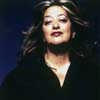
Zaha Hadid photo : Steve Double
Hadid, who received the Pritzker Prize in 2004, has since become one of the world’s busiest architects with projects in numerous countries, including the United States, China, Germany, Spain and Italy. The distinguished architecture critic Ada Louise Huxtable, who at the time was a Pritzker juror, said: “Zaha Hadid is one of the most gifted practitioners of the art of architecture today.”
With the addition of Breyer and Hadid, the Pritzker jury will now consist of eight people, including its chairman, Lord Palumbo of the United Kingdom, and (alphabetically) Alejandro Aravena from Chile, architect and executive director of Elemental; Yung Ho Chang, who is an architect and educator from Beijing, China, and is currently a professor at MIT; Australian architect Glenn Murcutt who is the 2002 Pritzker Laureate; Juhani Pallasmaa of Finland, who is an architect, professor and author; and Karen Stein, a writer, editor and architectural consultant in the U.S. Martha Thorne, who is the associate dean for external affairs at the IE School of Architecture in Madrid, Spain, is the executive director.
In making the announcement, Pritzker stated: “The members of the Pritzker jury are now, and always have been thoughtful, outstanding individuals from diverse backgrounds providing sometimes surprising insight to architectural achievement in our time. Our family is constantly proud and honored that these individuals are willing to give of their time in choosing architects to be singled out for excellence.”
The Pritzker Architecture Prize was established by The Hyatt Foundation in 1979 to honor annually a living architect whose built work demonstrates a combination of those qualities of talent, vision, and commitment, which has produced consistent and significant contributions to humanity and the built environment through the art of architecture. It has often been described as “architecture’s most prestigious award” or as “the Nobel of architecture.”
The prize takes its name from the Pritzker family, whose international business interests are headquartered in Chicago. They have long been known for their support of educational, social welfare, scientific, medical and cultural activities. Jay A. Pritzker, who founded the prize with his wife, Cindy, died on January 23, 1999. His eldest son, Thomas J. Pritzker, has become chairman of The Hyatt Foundation.
Pritzker Prize information from The Pritzker Prize
Location: Los Angeles, CA
Pritzker Architecture Prize Information
Pritzker Prize architects : main page with current winner information
Pritzker Prize 2011 Citation from the Jury + The Jury + Eduardo Souto de Moura information
Pritzker Prize 2010 : Information
Key Architecture Awards
World Architecture Festival Awards
Comments / photos for the Pritzker Architecture Prize Laureate 2012 page welcome
Website: Pritzker Prize

